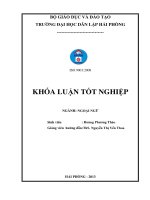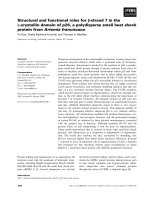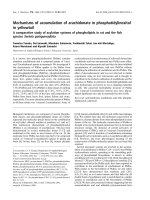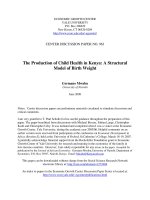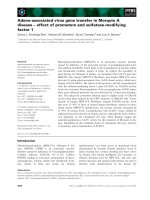proteomics in practice - a laboratory manual of proteome analysis - tom naven
Bạn đang xem bản rút gọn của tài liệu. Xem và tải ngay bản đầy đủ của tài liệu tại đây (10.7 MB, 329 trang )
Reiner Westermeier,
Tom Naven
Proteomics in Practice
Proteomics in Practice: A Laboratory Manual of Proteome Analysis
Reiner Westermeier, Tom Naven
Copyright 2002 Wiley-VCH Verlag GmbH
ISBNs: 3-527-30354-5 (Hardcover); 3-527-60017-5 (Electronic)
Related title from Wiley-VCH
Reiner Westermeier
Electrophoresis in Practice
Third Edition
ISBN 3-527-30300-6
Proteomics in Practice
A Laboratory Manual of
Proteome Analysis
Reiner Westermeier,
Tom Naven
Proteomics in Practice: A Laboratory Manual of Proteome Analysis
Reiner Westermeier, Tom Naven
Copyright 2002 Wiley-VCH Verlag GmbH
ISBNs: 3-527-30354-5 (Hardcover); 3-527-60017-5 (Electronic)
Dr. Reiner Westermeier
Dr. Tom Naven
Amershan Biosciences Europe GmbH
Munzinger Str. 9
79111 Freiburg
Germany
&
This book was carefully produced. Never-
theless, authors and publisher do not
warrant the information contained therein to
be free of errors. Readers are advised to keep
in mind that statements, data, illustrations,
procedural details or other items may inad-
vertently be inaccurate.
Library of Congress Card No.: applied for
British LibraryCataloguing-in-PublicationData:
A catalogue record for this book is available
from the British Library.
Die Deutsche Bibliothek ± CIP Cataloguing-
in-Publication Data:
A catalogue record is available from
Die Deutsche Bibliothek.
Wiley-VCH Verlag-GmbH
Weinheim, 2002
All rights reserved (including those of
translation in other languages).
No part of this book may be reproduced in
any form ± by photoprinting, microfilm, or
any other means ± nor transmitted or
translated into a machine language without
written permission from the publisher.
Registered names, trademarks, etc. used in
this book, even when not specifically marked
as such, are not to be considered unprotected
by law.
printed in the Federal Republic of Germany
printed on acid-free paper.
Composition Kühn & Weyh, Software
GmbH, Freiburg
Printing Druckhaus Darmstadt GmbH,
Darmstadt
Bookbinding J. Schäffer GmbH & Co. KG,
Grünstadt
ISBN 3-527-30354-5
Proteomics in Practice: A Laboratory Manual of Proteome Analysis
Reiner Westermeier, Tom Naven
Copyright 2002 Wiley-VCH Verlag GmbH
ISBNs: 3-527-30354-5 (Hardcover); 3-527-60017-5 (Electronic)
V
Preface IX
Foreword XI
Abbreviations, symbols, units XIII
Glossary of terms XVII
Part I: Proteomics Technology 1
1 Introduction 1
1.1 Applications of proteomics 6
1.2 Separation of the protein mixtures 6
1.3 Detection 7
1.4 Image analysis 7
1.5 Identification of proteins 8
1.6 Characterization of proteins 9
1.7 Functional proteomics 9
2 Expression proteomics 11
2.1 Two-dimensional Electrophoresis 11
2.1.1 Evolution of the 2-D methodology 12
2.1.2 Sample preparation 15
2.1.3 First Dimension: Isoelectric focusing 27
2.1.4 Second dimension: SDS-PAGE 57
2.1.5 Detection of protein spots 79
2.1.6 Image analysis 87
2.2 Spot handling 97
2.2.1 Spot cutting 98
2.2.2 Protein cleavage 100
2.3 Mass spectrometry 108
2.3.1 Ionisation 112
2.3.2 Ion separation 118
Contents
Proteomics in Practice: A Laboratory Manual of Proteome Analysis
Reiner Westermeier, Tom Naven
Copyright 2002 Wiley-VCH Verlag GmbH
ISBNs: 3-527-30354-5 (Hardcover); 3-527-60017-5 (Electronic)
VI
2.3.3 Tandem mass spectrometry (MS/MS) 125
2.4 Protein identification by database searching 135
2.4.1 Peptide mass fingerprint 136
2.4.2 Peptide mass fingerprinting combined with composition
information
138
2.4.3 Peptide mass fingerprint combined with partial sequence
information
139
2.4.4 Product ion MS/MS sequence data 143
2.4.5 De novo sequencing 145
2.5 Methods of proteome analysis 154
2.5.1 2D-MS 154
2.5.2 LC-MS/MS 157
2.5.3 Quantitative proteomics 159
Part II Course Manual 161
Equipment, Consumables, Reagents 163
Step 1: Sample preparation 169
1 Stock solutions 170
2 Examples 172
3 Microdialysis 175
4 Precipitation 177
5 Basic proteins 181
6 Very hydrophobic proteins 182
7 Quantification 184
8 SDS samples for HMW proteins separation 186
Step 2: Isoelectric focusing 187
1 Reswelling tray 188
2 Rehydration loading and IEF in IPGphor strip holders 190
3 IEF in the cup loading strip holder (rehydration loaded strips) 192
4 Cup loading IEF 194
5 Staining of IPG strips 196
Step 3: SDS Polyacrylamide Gel Electrophoresis 199
1 Casting of SDS polyacrylamide gels 199
1.1 Stock solutions 199
1.2 Cassettes for laboratory made gels 201
1.3 Multiple Gel Caster (up to 14 gels) 203
1.3.2 Homogeneous gels 204
1.3.3 Gradient gels 207
1.4 Gel Caster for up to six gels 212
2 Inserting ready-made gels into cassettes 219
3 Preparation of the SDS electrophoresis equipment 222
Contents
VII
3.1 Stock solutions for the running buffers 222
3.2 Setting up the integrated high-throughput instrument 223
3.3 Setting up the six gel instrument 223
4 Equilibration of the IPG strips and transfer to the SDS gels 224
4.1 Equilibration 224
4.2 Application of the IPG strips onto the SDS gels 224
4.3 Application of molecular weight marker proteins and 1-D samples 226
4.4 Seal the IPG strip and the SDS gel 226
5 The SDS electrophoresis run 227
5.1 The integrated high-throughput instrument 227
5.2 The six-gel instrument with standard power supply 229
Step 4: Staining of the gels 233
1 Colloidal Coomassie Brilliant Blue staining 233
1.1 Solutions 233
1.2 Staining 234
2 Hot Coomassie Brilliant Blue staining 234
3 Silver staining 235
4 Fluorescence staining 238
5 Preserving and drying of gels 238
Step 5: Scanning of gels and image analysis 239
1 Scanning 239
1.1 Gels stained with visible dyes 239
1.2 Scanning fluorescent dyes 241
2 Spot detection and background parameters 241
2.1 Automated spot detection 241
2.2 Spot filtering 242
2.3 Spot editing 242
2.4 Background correction 243
3 Evaluation of 2-D patterns 243
3.1 Reference gel 243
3.2 Automatic gel matching 244
3.3 Normalisation 245
3.4 pI and M
r
calibration 245
3.5 Difference maps 246
3.6 Averaged gels 247
3.7 Quantification 247
3.8 Creating reports 247
3.9 Spot picking 247
Step 6: Fluorescence difference gel electrophoresis 249
1 Preparing a cell lysate compatible with CyDye labelling 250
2 Reconstituting the stock CyDye in Dimethylformamide (DMF) 251
3 Preparing CyDye solution used to label proteins 252
Contents
VIII
Step 7: Spot excision 255
Step 8: Sample destaining 259
Step 9: In-gel digestion 261
Step 10: Microscale desalting and concentration of sample 263
Step 11: Chemical derivatisation of the peptide digest 265
Step 12: MS analysis 269
Step 13: Calibration of the MALDI-ToF MS 273
Step 14: Preparing for a database search 277
Step 15: PMF database search unsuccessful 281
A Trouble shooting 283
1 Two-dimensional Electrophoresis 283
1.1 Isoelectric focusing in IPG strips 283
1.2 SDS PAGE 285
1.3 Staining 286
1.4 DIGE fluorescence labelling 287
1.5 Results in 2-D electrophoresis 288
2 Mass spectrometry 291
References 295
Index 311
Contents
The objective of Proteomics in Practice is to provide the reader with a
comprehensive reference and manual guide for the successful analy-
sis of proteins by 2-D electrophoresis and mass spectrometry. The
idea for the book has come from the continuing success and favoura-
ble responses received from the scientific public for our on-going pro-
teomics seminar and practical courses we have delivered in the past
twelve months.
The book will include a theoretical introduction, comprehensive
practical section complete with worked examples, a unique troubles-
hooting section designed to answer many of the frequently asked
questions regarding proteome analysis and a thorough reference list
to guide the interested reader to further detail.
The theoretical section will introduce the fundamentals behind the
techniques currently being used in proteomics today and describe
how the techniques are used for proteome analysis.
However, the practical aspects of the book will not address many of
these methods, but will instead focus on the main stream methodolo-
gy of 2-D electrophoresis and mass spectrometry. 2-D electrophoresis
is still the most successful method of resolving a proteome with
increasing reproducibility and automation. All aspects for the suc-
cessful performance of 2-D electrophoresis and image analysis will be
addressed in practical detail. Subsequently, the importance of mass
spectrometry, sequence databases and search engines for successful
protein identification will be discussed. The practical section of the
book is in principle a course manual, which has been optimized over
a number of years. The success of the ªElectrophoresis in Practiceº
book range, has demonstrated that a course manual is a useful guide
for daily work in the laboratory. The section will describe how to
achieve good, reliable and reproducible results using a single instru-
mental setup, instead of presenting a wide choice of techniques and
instruments. In this book some statements may be found, which do
not comply with the ªhigh endº technological achievements pub-
IX
Preface
Proteomics in Practice: A Laboratory Manual of Proteome Analysis
Reiner Westermeier, Tom Naven
Copyright 2002 Wiley-VCH Verlag GmbH
ISBNs: 3-527-30354-5 (Hardcover); 3-527-60017-5 (Electronic)
Preface
lished. The experimental procedures are restricted to the area of
robustness and routinely achievable good results.
The authors understand and wholly appreciate that the analysis of
post-translational modifications such as phosphorylation and glycosy-
lation is an integral aspect of proteomics. As such the theoretical,
technical and practical issues involved will be addressed in great
detail in a subsequent edition. Approaches for functional proteomics
are still varying and many procedures are under development. These
methods will be added in a later edition.
As the technical developments in this field are proceeding so fast,
the contents of the book need to be updated every few months. The
reader can have access to a web-site at WILEY-VCH:
-
terscience.wiley.com/XXXXXX, which will contain the updated chap-
ters and recipes.
Reiner Westermeier
Tom Naven January 2002
Thanks to:
Jan Axelsson, Tom Berkelman, Philippe Bogard, Josef Bülles, Maria
Liminga, Tom Keough, Matrixscience.com, Staffan Renlund, Günter
Thesseling.
X
XI
Proteomics is in an extraordinary growth phase. This is due to a great
extent to the fact that the major undertaking of sequencing the
human and other important genomes has largely been accomplished,
which has opened the door for proteomics by providing a sequence-
based framework for mining the human proteome and that of other
organisms. It is evident that proteomics has attracted a substantial
following, with an influx of investigators and of biotechnology and
pharmaceutical companies that are taking an active interest in the
field, as well as an influx of a new generation of scientists in training.
There is undeniably a pressing need for training in proteomics and
much need for textbooks that facilitate the use of related methodolo-
gy. This book makes a valuable contribution by providing a clear pre-
sentation of some of the most widely utilized methods in this field.
The field of proteomics can be divided in practice into three major
areas: expression proteomics, functional proteomics and proteome
related bioinformatics. This book focuses primarly on methodology
utilized for expression proteomics, an important component of pro-
teomics which deals with global quantitative analysis and identifica-
tion of proteins encoded in genomes and expressed to a varied extent
in different tissues and cell populations. Expression proteomics relies
on a mix of, on the one hand, high-tech approaches and on the other,
a harvest of know-how in protein chemistry and biochemistry gained
over the past half-century. Although the face of proteomics is evolving
right before our eyes, it is likely that some fundamental technologies
will remain in use for many years to come. This is likely to be the
case for the technologies and methodologies covered in this book,
namely 2-D methods and related mass spectrometry techniques for
protein identification, with which the field of proteomics has been
tightly associated in the past decade.
Evidently, 2-D gels have come under assault lately, due in part to
the influx of new investigators to the field, most of whom have no
particular leanings towards 2-D gels and consider the lack of automa-
tion and the limited sensitivity of 2-D gels as major drawbacks. While
Foreword
Proteomics in Practice: A Laboratory Manual of Proteome Analysis
Reiner Westermeier, Tom Naven
Copyright 2002 Wiley-VCH Verlag GmbH
ISBNs: 3-527-30354-5 (Hardcover); 3-527-60017-5 (Electronic)
Foreword
non-2-D gel based approaches such as protein microarrays and multi-
dimensional liquid based separations, and peptide (as opposed to pro-
tein) profiling are making some inroads, a technology that is clearly
superior to 2-D gels for global proteome profiling has yet to emerge.
Clearly, industry is after a robust ªindustrial strengthº proteomic plat-
form to achieve high throughput, which 2-D gels with their limited
automation at the present time do not adequately provide. However a
more pressing concern of most investigators contemplating using 2-
D gels is how to overcome the difficulties and challenges notoriously
associated with this technique. Indeed, much ªartº is needed to pro-
duce quality 2-D gels, which in the past has limited the successful
use of this technique to a privileged few. Numerous ªtricksº need to
be learned, for which this text is quite valuable. Equally, from a mass
spectrometry point of view, although spectacular progress has been
made in this field with the development of instrumentation that is
highly performing and much more user friendly than in the past,
much needs to be mastered for the optimal utilization of mass spec-
trometry. There remains much challenge in protein identification,
which this book is intended to facilitate, particularly for those ente-
ring the field.
A valuable contribution of this book is the manner in which the
methodologies used for 2-D gels and mass spectrometry have been
integrated. It is rare to find scientists with expertise in mass spec-
trometry that are also knowledgeable in the practical aspects of suc-
cessfully producing quality 2-D gels. The combined backgrounds of
the two authors is ideally suited to provide readers with a comprehen-
sive and expert presentation of methodology utilized to successfully
combine 2-D gels and mass spectrometry. In my own laboratory, I
predict that this book will make a valuable contribution to the trai-
ning of graduate students, post-doctoral fellows and technologists
that are joining the laboratory. As the field is constantly evolving, the
planned frequent updates would be valuable to keep the text current.
Sam Hanash MD, PhD
Department of Pediatrics
A 520 MSRBI
University of Michigan
Ann Arbor MI 48109
USA
XII
XIII
1-D electrophoresis One-dimensional electrophoresis
2-D electrophoresis Two-dimensional electrophoresis
A Ampere
A,C,G,T Adenine, cytosine, guanine, thymine
AEBSF Aminoethyl benzylsulfonyl fluoride
API Atmospheric pressure ionization
APS Ammonium persulfate
AU Absorbance units
16-BAC Benzyldimethyl-n-hexadecylammonium
chloride
BAC Bisacryloylcystamine
Bis N, N¢-methylenebisacrylamide
BLAST Basic local alignment search tool
bp Base pair
BPB Bromophenol blue
BSA Bovine serum albumin
C Crosslinking factor [%]
CAF Chemically assisted fragmentation
CAM Co-analytical modification
CAPS 3-(cyclohexylamino)-propanesulfonic acid
CBB Coomassie brilliant blue
CCD Charge-coupled device
CHAPS 3-(3-cholamidopropyl)dimethylammonio-1-
propane sulfonate
CE Capillary electrophoresis
CID Collision induced dissociation
conc Concentrated
CM Carboxylmethyl
CMW Collagen molecular weight marker
const. Constant
CTAB Cetyltrimethylammonium bromide
Da Dalton
DB Database
Abbreviations, symbols, units
Proteomics in Practice: A Laboratory Manual of Proteome Analysis
Reiner Westermeier, Tom Naven
Copyright 2002 Wiley-VCH Verlag GmbH
ISBNs: 3-527-30354-5 (Hardcover); 3-527-60017-5 (Electronic)
Abbreviations, symbols, units
DBM Diazobenzyloxymethyl
DDRT Differential display reverse transcription
DEA Diethanolamine
DEAE Diethylaminoethyl
DGGE Denaturing gradient gel electrophoresis
2,5-DHB 2,5-dihydroxybenzoic acid
Disc Discontinuous
DMF Dimethyl formamide
DMSO Dimethylsulfoxide
DNA Desoxyribonucleic acid
dpi dots per inch
DTE Dithioerythreitol
DTT Dithiothreitol
E Field strength in V/cm
EDTA Ethylenediaminetetraacetic acid
ESI Electrospray ionization
EST Expressed sequence tag
FAB Fast atom bombardment
FT-ICR Fourier transform ± Ion cyclotron resonance
GLP Good laboratory practice
GMP Good manufacturing practice
h Hour
HCCA a-cyano-4-hydroxycinnamic acid
HeNe Helium neon
HEPES N-2-hydroxyethylpiperazine-N¢-2-ethanane-
sulfonic acid
HMW High Molecular Weight
HPLC High Performance Liquid Chromatography
I Current in A, mA
ICAT Isotope coded affinity tags
IEF Isoelectric focusing
IgG Immunoglobulin G
IPG Immobilized pH gradients
ITP Isotachophoresis
kB Kilobases
kDa Kilodaltons
LC Liquid chromatography
LMW Low Molecular Weight
LOD Limit of detection
LWS Laboratory workflow system
M mass
mA Milliampere
MALDI Matrix assisted laser desorption ionization
min Minute
mol/L Molecular mass per liter
XIV
Abbreviations, symbols, units
mr Relative electrophoretic mobility
mRNA messenger RNA
MS Mass spectrometry
MS
n
Tandem mass spectrometry where n is greater
than 2
MS/MS Tandem mass spectrometry
M
r
relative molecular mass
m/z mass/charge ratio (x-axis in a mass spectrum)
Nonidet Non-ionic detergent
NEPHGE Non equilibrium pH gradient electrophoresis
NHS N-hydroxy succinimide
NR Non redundant
O.D. Optical density
P Power in W
PAG Polyacrylamide gel
PAGE Polyacrylamide gel electrophoresis
PAGIEF Polyacrylamide gel isoelectric focusing
PBS Phosphate buffered saline
PEG Polyethylene glycol
pI Isoelectric point
pK value Dissociation constant
PMF Peptide mass fingerprint
PMSF Phenylmethyl-sulfonyl fluoride
PPA Piperidino propionamide
ppm parts per million (measure of mass accuracy)
PSD Post source decay
PTM Post-translational modification
PVC Polyvinylchloride
PVDF Polyvinylidene difluoride
QTOF quadrupole time-of-flight
r Molecular radius
Rf value Relative distance of migration
Rm Relative electrophoretic mobility
RNA Ribonucleic acid
RP Reversed Phase
rpm revolutions per minute
RuBPS Ruthenium II tris (bathophenanthroline
disulfonate)
s Second
SDS Sodium dodecyl sulfate
S/N Signal/noise ratio
T Total acrylamide concentration [%]
t Time, in h, min, s
TBS Tris buffered saline
TCA Trichloroacetic acid
XV
Abbreviations, symbols, units
TEMED N,N,N¢,N¢-tetramethylethylenediamine
THPP Tris(hydroxypropyl)phosphine
ToF Time of Flight
Tricine N,tris(hydroxymethyl)-methyl glycine
Tris Tris(hydroxymethyl)-aminoethane
U Volt
V Volume in L
v Speed of migation in m/s
v/v Volume per volume
W Watt
w/v Weight per volume (mass concentration)
XVI
XVII
Term Definition
Adduct peak Results from the photochemical breakdown of the
matrix into more reactive species, which can add to
the polypeptide. Can also result from salt ions, Na
+
etc., that are embedded in the matrix.
Analytical
2-D electrophoresis
Proteins are loaded in amounts of 10 to 100 lg.
Mostly broad pH intervals are used in the first dimen-
sion.
Average molecular
weight
<2093.8>
average molecular weight
The mass of a molecule of a given empirical formula
calculated using the average atomic weights for
each element. An average mass is obtained in
MALDI-TOF-MS when a peak is not isotopically
resolved (see mono-isotopic molecular weight).
Background subtraction The process in which the background (chemical and
detector noise) is subtracted, leaving the peaks above
the noise at the base level.
Base peak The most intense peak in a mass spectrum. A mass
spectrum is usually normalized so that this peak has
an intensity of 100%.
Calibrant A compound used for the calibration of an instru-
ment.
Calibration A process where known masses are assigned to select-
ed peaks. The purpose is to improve the mass accu-
racy of an MS instrument.
Glossary of terms
Proteomics in Practice: A Laboratory Manual of Proteome Analysis
Reiner Westermeier, Tom Naven
Copyright 2002 Wiley-VCH Verlag GmbH
ISBNs: 3-527-30354-5 (Hardcover); 3-527-60017-5 (Electronic)
Glossary of terms
Term Definition
Centroided mass peak The centroided mass peak is located at the weighted
centre of mass of the profile peak.
Collision induced
dissociation (CID)
A process whereby an ion of interest, the precursor
ion, is selected, isolated, excited and fragmented by
collisions with an inert gas within the mass spectrom-
eter.
Dalton (Da) According to the guidelines of the SI, the use of the
term Dalton for 1.6601 10
±27
kg is no longer recom-
mended. However it is still a current unit in bioche-
mistry.
Daughter ion (see
product or fragment ion)
An ion resulting from CID performed on a precursor
ion during a product ion MS/MS spectrum.
Digestion Cleavage of subject protein by proteolytic enzymes,
including trypsin and chymotrypsin.
Dried droplet method Sample preparation method for MALDI-TOF MS
applicable to peptides, protein digests and full length
proteins.
Electrospray ionisation
(ESI)
An ionisation technique, which enables the forma-
tion of ions from molecules directly from samples in
solution. The ions formed in this process are predom-
inantly multiply charged. Commonly coupled with
analysers capable of tandem mass spectrometry (MS/
MS). It is readily coupled with HPLC or capillary elec-
trophoresis.
Electroendosmosis In an electric field, fixed charges on the gel matrix or
on a glass surface are attracted by the electrode of
opposite sign. As they are fixed, they cannot migrate.
This results in a compensation by the counterflow of
H
3
O
+
ions towards the cathode for negative or OH
±
ions towards the anode for positive charges. In gels,
this effect is observed as a water flow.
Expression proteomics The massive parallel study of highly heterogeneous
protein mixtures with high throughput techniques
like 2-D electrophoresis and MALDI mass
spectrometry.
External calibration A calibration is performed with a known calibration
mixture. The resultant calibration constants (file) are
then applied to a separate sample.
Fragment ion (product
or daughter ion)
See product ion.
XVIII
Glossary of terms
Term Definition
Fragmentation A physical process of dissociation of molecules into
fragments in a mass spectrometer. The resultant
spectrum of fragments is unique to the molecule or
ion. Fragmentation data can be used to sequence
peptides and resultantly provide data for protein
identification.
Full length protein An intact polypeptide chain, constituting a protein in
its native or denatured state. The molecular weight of
which can be determined accurately with MALDI and
ESI MS.
Functional proteomics This research is only possible with non-denatured cell
extracts and requires different tools than 2-D electro-
phoresis and MALDI MS. A smaller subset of pro-
teins is isolated from the highly heterogeneous pro-
tein lysate and analysed with mild techniques that do
not affect protein complexes and three-dimensional
structures.
Immobilized
pH gradients
Polyacrylamide gels, which contain an in-built pH
gradient, created by acrylamide derivatives, which
carry acidic and basic buffering groups. Because an
immobilized pH gradient is absolutely continuous,
narrow pH intervals can be prepared, which allow
unlimited resolution.
In-gel digestion The embedded protein in the gel is cleaved using
enzymes of known specificity. During the process,
peptides are formed, which are extracted from the gel
for subsequent analysis.
Internal calibration Calibration where known masses in each spectrum
are used to calibrate that spectrum. Greater mass
accuracy than an external calibration.
Ion detector. A detector that amplifies and converts ions into an
electrical signal
Ion gate Typically an electrical deflector that permits certain
ions through to later stages of ion optics (open), or
deflects unwanted ions out of the way of the later sta-
ges of the mass spectrometer. Commonly used in
post-source decay (PSD) analysis for the selection of a
precursor ion.
Ion source Region of the mass spectrometer where gas phase
ions are produced.
Ion transmission
efficiency
Refers to the fraction of the ions produced in the
source region that actually reaches the detector.
Ionisation The process of converting a sample molecule into an
ion in a mass spectrometer.
XIX
Glossary of terms
Term Definition
Isoelectric point (pI) The pH value where the net charge of an amphoteric
substance is zero. Because the pK values of buffering
groups are temperature-dependent, this is valid also
for the pI. The pI of a protein that can be measured.
Isotope Atoms of the same element having different mass
numbers due to differences in the number of neu-
trons.
Isotope abundance The relative amount in nature of certain atomic
isotopes.
Laboratory workflow
system
Database and computer network for the integrated
laboratory to control the entire workflow in the
proteomics factory.
Linear time-of-flight
mass analyser
Simplest TOF analyser, consisting of a flight tube
with an ion source at one end and a detector at the
other.
Mass accuracy The ability to assign the actual mass of an ion. This is
typically expressed as an error value.
Mass analyser Second part of the mass spectrometer, separating the
ions forms in the ion source according to their m/z
value. Examples of mass analysers include ion trap,
quadrupole, time-of-flight and magnetic sector.
Mass range The area of interest to be measured in an experiment.
Or the capability of the analyser
Mass spectrometer An instrument that measures the mass to-charge
ratio (m/z) of ionized atoms or molecules. Comprises
three parts: an ion source, a mass analyser, and an
ion detector.
Mass spectrometry
(MS)
A technique for analysing the molecular weight of
molecules based upon the motion of a charged parti-
cle in an electric or magnetic field.
Mass spectrum A plot of ion abundance (y-axis) against mass-to-
charge ratio (x-axis).
Mass-to-charge ratio
(m/z)
A quantity formed by dividing the mass of an ion (in
Da units) by the number of charges carried by the
ion.
Matrix Necessary for the ionisation of sample molecules by
MALDI. A small, organic compound which absorbs
light at the wavelength of the laser.
Matrix-assisted laser
desorption/Ionisation
(MALDI)
Ionisation technique, commonly used for the
ionisation of biological compounds. Sample is incor-
porated into the crystal structure of the matrix and
irradiated with the light from a laser.
Metastable ion An ion that decomposes into fragment ions and/or
neutral species, during its passage through the mass
spectrometer.
XX
Glossary of terms
Term Definition
Monoisotopic molecular
weight
2092.6
monoisotopic molecular weight
The mass of a molecule containing only the most
abundant isotopes, calculated with exact atomic
weights. With respect to peptide analysis, the mono-
isotopic peak is the
12
C peak, i.e. the first peak in the
peptide isotopic envelope.
Multiple-charged ion Ion possessing more than a single charge. Characteri-
stic of ESI
Normalization All peaks are reported with peak heights relative to
the highest peak height or area in the spectrum.
Neutral loss scan A type of MS/MS experiment. Useful for the indica-
tion of individual components in a complex mixture.
N-terminal amino acid The amino acid residue at the end of a polypeptide
chain containing the free amino group.
Parent ion (precursor ion) Refers to the peak of an ion that will be selected for
fragmentation in a product ion MS/MS or PSD spec-
trum.
Molecular mass (M
r
) The relative molecular mass is dimensionless. In
practice and in publication the dimension Da (Dal-
ton) is used. Particularly in electrophoresis the term
ªMolecular weightº is frequently used.
Optical Density (O.D.) The unitO.D. for the optical density is mostly used in
biology and biochemistry and is defined as follows:
1 O.D. is the amount of substance, which has an
absorption of 1 when dissolved and measured in
1 mL in a cuvette with a thickness of 1 cm.
Peptide-mass fingerprin-
ting
Technique for searching protein databases for protein
ID. Subject protein is cleaved and the resultant clea-
ved peptide masses are used for a database search.
Peak area The area bounded by the peak and the base line. Can
be calculated by integrating the abundances from the
peak start to the peak end.
Peak height The distance between the peak maximum and the
baseline.
Peak resolution The extent to which the peaks of two components
overlap or are separated. Compare with FWHM.
Peak width The width of a peak at a given height.
XXI
Glossary of terms
Term Definition
Phosphate buffered
saline (PBS):
140 mol/L NaCl, 2.7 mmol/L KCl, 6.5 mmol/L
Na
2
HPO
4
, 1.5 mmol/L KH
2
PO
4
, pH 7.4.
Post-source decay (PSD) A technique describing fragmentation of a precursor
ion that occurs in the first field free region of the
TOF before the reflectron.
Post-translational
modification (PTM)
Modifications of proteins occuring after coding; com-
mon examples include phosphorylation and
glycosylation. PTM analysis is an integral part of
proteomics.
Precursor ion (parent ion) Ion selected to undergo fragmentation within the
mass spectrometer in a product ion MS/MS or PSD
spectrum.
Precursor ion scan A type of MS/MS experiment. Useful for the indica-
tion of individual components in a complex mixture.
Preparative 2-D
electrophoresis
Proteins are loaded in the lower mg amounts. Mostly
narrow pH intervals are used in the first dimension.
Product ion (see
daughter ion)
An ion resulting from CID performed on a precursor
ion during a product ion MS/MS spectrum.
Product ion scan The principle MS/MS experiment. Involves the selec-
tion of a precursor ion to undergo fragmentation
within the MS.
Protein characterization The identification of structural aspects of a protein.
Includes amino acid sequence, molecular weight,
three-dimensional structure, post-translational modi-
fications and biologic activity of a particular protein.
Protein sequencing The determination of the order of amino acids in a
subject protein or peptide.
Proteome The complete profile of proteins expressed in a given
tissue, cell or biological system at a given time.
Proteomics Systematic analysis of the protein expression of heal-
thy and diseased tissues.
Pulsed mass analyser Includes time-of-flight, ion cyclotron resonance, and
quadrupole ion traps. An entire mass spectrum is col-
lected from a single pulse of ions.
Quantification In many papers the term ªquantitationº is used,
which is incorrect. In gel electrophoresis only relative
quantification is possible, but the adjective ªrelativeº
is omitted in most papers on this subject.
Reflectron Improves resolution of a mass spectrometer by acting
act as an ion mirror. Compensates for the distribution
of kinetic energy, ions of the same mass experience
in the source.
XXII
Glossary of terms
Term Definition
Rehydration The correct word is ªrehydratationº. Because this
word is a tongue-twister and is used many times for
the methodical description of the first dimension sep-
aration, the incorrect term ªrehydrationº is generally
used.
Resolution
10 % valley
10 %
m∆
Refers to the separation of two ions where resolution,
R= m/Dm. For a single peak made up of singly char-
ged ions at mass m in a mass spectrum, the res-
olution maybe expressed as m/D where Dm is the
width of the peak at a height that is a specified frac-
tion of the maximum peak height (for instance full
width at half maximum height ± FWHM). A second
definition for defining resolution is 10% valley.
Two peaks of equal height in a mass spectrum at mas-
ses m and m-Dm are separated by a valley that at its
lowest point is just 10% of the height of either peak.
Resolving power (mass)
5000
5001
mass resolution
The abilitity to distinguish between ions differing
slightly in mass-to-charge ratio.
Sample preparation A crucial stage to achieve efficient, optimal ionisation.
SDS electrophoresis Proteins are separated in a polyacrylamide gel as neg-
atively charged protein-detergent micelles. Secondary,
tertiary, quaternary structures and the individual
charges of the proteins are cancelled. The migration
distances of the resulting zones from the origin corre-
late roughly to the logarithm of the M
r
of the respec-
tive protein.
XXIII
Glossary of terms
Term Definition
Seeded microcrystalline
film Method
A sample preparation method. First, a thin layer of
small matrix crystals is formed on the sample slide.
Then a droplet containing the analyte is placed on top
of this layer. This is left to dry. The deposit is washed
before the sample slide is inserted into the mass spec-
trometer. Is a direct replacement of the dried droplet
method.
Signal-to-noise ratio
(S/N)
The ratio of the signal height and the noise height.
An indication of the sensitivity of an instrument or
analysis.
Slow crystallization
Method
A sample preparation method. Here, large matrix cry-
stals are grown. The analyte is added to a saturated
matrix solution. Microcrystals are formed. The super-
natant is removed and a slurry of crystals is made.
The slurry is then applied to the sample slide, allowed
to dry and inserted into the mass spectrometer. Can
be used when the dried droplet method has failed
Tandem mass
spectrometry (MS/MS)
Used to elucidate structure within the mass spec-
trometer. Three types of MS/MS experiment can be
performed.
Thin layer method A sample preparation method. Applying the matrix
onto the substrate creates a very thin layer of matrix.
A droplet of the analyte is then dried onto this layer.
Contaminants can now be washed away before intro-
ducing the sample into the mass spectrometer. A
variant of the dried droplet method.
Threshold fluence. The lowest laser fluence at which analyte can be ob-
served in MALDI, fluence for optimal resolution.
Time-ion extraction
(time lag focussing or
delayed extraction)
Improved resolution is obtained for a specified mass
range by applying a controlled delay between ion for-
mation and acceleration, also called delayed extrac-
tion.
Time-of-flight (TOF)
analyser
Separates ions in time as they travel down a flight
tube.
Tuning The process of optimising the MALDI instrument's
laser power and target position to obtain the best pos-
sible sensitivity and signal-to-noise ratio for a specific
type of experiment.
Two-dimensional
electrophoresis
There are more than one possibility to combine two
different electrophoretic separation principles. If not
further specified, 2-D electrophoresis means isoelec-
tric focusing under denaturing conditions followed
by SDS polyacrylamide gel electrophoresis.
Unit resolution Distinguishes between ions separated by 1 m/z unit.
XXIV
311
1-D samples 186, 187, 226
2D Fluorescence Difference Gel
Electrophoresis 85
2D-MS 154
a
a-ion 128
abundant proteins 47, 192
Acid violet 17 52
staining, IPG strips 196
acrylamide 59, 199
acrylamide derivatives 31
additives 35, 50
affinity chromatography and LC-MS/MS
158
affinity interaction 159
agarose sealing 69, 224
albumin 26
alkali metal salts 264
alkylation 75
amino acid modification 278
amino acid sequence 79
ammonium bicarbonate 264
amphoteric buffers 15
amphoteric molecules 27
analytical applications 19
anodal buffer 222
application point 51
automated
image analysis 96
sample preparation 27
automated stainer 236
averaged gels 247
average mass 279
averaging gels 90, 95
b
b-ion 128
b-ion series 127, 147
backed gels 88
background 35
subtraction, correction 92
background subtraction 243
backing, film or glass 67
barcodes 97
basic NHS ester 148
basic pH gradients 34, 50, 39
basic proteins 13-14, 17-18, 169, 181
Bind-Silane 68, 202
bioinformatics 5
biotinylation 158
Bis 200
blue dextrane 26
body fluids, human 25
Bromophenol blue 18, 75
buffer
concentration 73
depletion 222
leakage 72
tank 73
buffering capacity 30
c
c-terminal ion series 127
CAF chemistry 144, 265
CAF MALDI 155
calf liver 174
calibration 273
1-D 54, 79, 94, 245
2-D 54, 79, 94
scanner 88, 240
capillary electrophoresis 118
carbon dioxide 38
carrier ampholytes 13, 17
cartesian coordinate system 76
casting, SDS gels 199
catalysts 66
cathodal buffer 222
Index
Proteomics in Practice: A Laboratory Manual of Proteome Analysis
Reiner Westermeier, Tom Naven
Copyright 2002 Wiley-VCH Verlag GmbH
ISBNs: 3-527-30354-5 (Hardcover); 3-527-60017-5 (Electronic)

